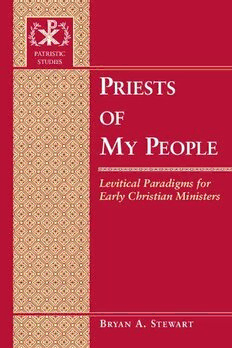
Priests of my People: Levitical Paradigms for Early Christian Ministers PDF
Preview Priests of my People: Levitical Paradigms for Early Christian Ministers
PATRISTIC STUDIES P RIESTS OF M P Y EOPLE Levitical Paradigms for Early Christian Ministers B A. S RYAN TEWART This book offers an innovative examination of the question: why did early Christians begin calling their ministerial leaders “priests” (using the terms hiereus/sacerdos)? Scholarly consensus has typically suggested that a Christian “priesthood” emerged either from an imitation of pagan priesthood or in connection with seeing the Eucharist as a sacrifice over which a “priest” must preside. This work challenges these claims by exploring texts of the third and fourth century where Christian bishops and ministers are first designated “priests”: Tertullian and Cyprian of Carthage, Origen of Alexandria, Eusebius of Caesarea, and the church orders Apostolic Tradition and Didascalia Apostolorum. Such an examination demonstrates that the rise of a Christian ministerial priesthood grew more broadly out of a developing “religio-political ecclesiology.” As early Christians began to understand themselves culturally as a unique polis in their own right in the Greco-Roman world, they also saw themselves theologically and his- torically connected with ancient biblical Israel. This religio-political ecclesiology, sharp- ened by an emerging Christian material culture and a growing sense of Christian “sacred space,” influenced the way Christians interpreted the Jewish Scriptures typo- logically. In seeing the nation of Israel as a divine nation corresponding to themselves, Christians began appropriating the Levitical priesthood as a figure or “type” of the Christian ministerial office. Such a study helpfully broadens our understanding of the emergence of a Christian priesthood beyond pagan imitation or narrow focus on the sacrificial nature of the Eucharist, and instead offers a more comprehensive explanation in connection with early Christian ecclesiology. “Priests of My Peopleis a fresh contribution to our understanding of the historical develop- ment of the ‘priesthood.’ Bryan A. Stewart shows that the Christian bishop was not, as is com- monly held, called priest because he presided at the sacrifice of the Eucharist. Rather it was as head of the community, the new Israel, the Christian polisthat the term priest came into gen- eral usage. This provocative book breaks through the shibboleths that have marked Protestant and Catholic debates to offer an ecumenical understanding of the Christian ministry. Robert Louis Wilken, William R. Kenan, Jr., Professor of the History of Christianity Emeritus, The University of Virginia BRYANA. STEWARTreceived his B.A. in religion from Grove City College (Grove City, PA) and his M.Div. from Covenant Theological Seminary (St. Louis, MO). He completed his Ph.D. in patristics and early Christianity from the University of Virginia (Charlottesville, VA). After completing his doctoral work, he was awarded a two-year Lilly post-doctoral teaching and research fellowship at Valparaiso University (Valparaiso, IN). Currently Stewart is Associate Professor of Religion at McMurry University (Abilene, TX), where he teaches the history of Christian thought. www.peterlang.com P M P RIESTS OF Y EOPLE Advance Praise for “This book is valuable simply for challenging the widespread assumptions that the Christian ‘priesthood’ came to be around 200 due to pagan models or to a new understanding of the Eucharist as a sacrifice. Far more than this, however, Bryan A. Stewart demonstrates that the late-second- and early-third-century designation of Christian ministers as ‘priests’ richly exemplifies development of doctrine—not merely the development of ideas, but rather ideas thoroughly contextualized within Christian material culture, sacred space, and religio-political worldview. As Stewart makes clear, the newly developed typological connections with the Levitical priesthood accord with the trajectory of the New Testament and the Apostolic Fathers, in a manner that prior scholars overlooked. This erudite and rewarding book is a major step forward for those interested in how doctrine developed in the early Church.” Matthew Levering, Perry Family Foundation Professor of Theology, Mundelein Seminary “Bryan A. Stewart deploys a supple ‘religio-political ecclesiology’ and notions of sacred space to explain the emergence of a new, Christian form of priestly leadership in the early church. Understanding the church as itself a polis provided the context in which early Christians drew parallels between the Levitical, Aaronic priests of Israel and the new ministers who presided over Christian communities. Stewart’s historical case is compelling, and along the way he makes an important contribution to long- standing ecumenical debates concerning the nature and sources of the Christian ministry.” Peter Leithart, President, Theopolis Institute, Birmingham, Alabama P M P RIESTS OF Y EOPLE P ATRISTIC S TUDIES Gerald Bray General Editor Vol. 11 This book is a volume in a Peter Lang monograph series. Every volume is peer reviewed and meets the highest quality standards for content and production. PETER LANG New York Bern Frankfurt Berlin Brussels Vienna Oxford Warsaw B A. S RYAN TEWART P M P RIESTS OF Y EOPLE Levitical Paradigms for Early Christian Ministers PETER LANG New York Bern Frankfurt Berlin Brussels Vienna Oxford Warsaw Library of Congress Cataloging-in-Publication Data Stewart, Bryan A. Priests of my people: Levitical paradigms for early Christian ministers / Bryan A. Stewart. pages cm. — (Patristic studies; Vol. 11) Includes bibliographical references and index. 1. Priesthood—History of doctrines—Early church, ca. 30–600. 2. Pastoral theology—History of doctrines—Early church, ca. 30–600. I. Title. BR195.P36S74 262’.1413—dc23 2014043814 ISBN 978-1-4331-2761-8 (hardcover) ISBN 978-1-4539-1453-3 (e-book) ISSN 1094-6217 Bibliographic information published by Die Deutsche Nationalbibliothek. Die Deutsche Nationalbibliothek lists this publication in the “Deutsche Nationalbibliografie”; detailed bibliographic data are available on the Internet at http://dnb.d-nb.de/. © 2015 Peter Lang Publishing, Inc., New York 29 Broadway, 18th floor, New York, NY 10006 www.peterlang.com All rights reserved. Reprint or reproduction, even partially, in all forms such as microfilm, xerography, microfiche, microcard, and offset strictly prohibited. To Jennifer for her understanding and unceasing encouragement, and Robert L. Wilken for the generosity of his time and support
